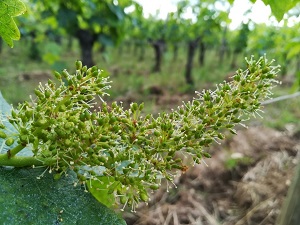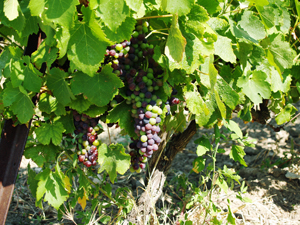Replenishing the water tables and keeping the frost at bay
It rained regularly back in January at the start of 2018, allowing the water reserves to be replenished. Then in February, the cold set in, which is a good thing for the vines because it enables them to rest and also kills off some of the parasites that live in the soil and can bring disease to the vines.
Spring was generally sunny and warm, meaning that the buds burst fairly early. For example in the Cotes du Rhone region, the bud burst was two weeks earlier than usual at Domaine de la Guicharde. At that time, back in April, frost was the biggest threat. Most of our organic winery partners had put in place some defence system, whether it be candles or bales of hay ready to burn and heat the air, or wind turbines to mix the warmer air with cooler air. Part of the Loire, Bordeaux and Languedoc regions were particularly touched, whereas the impact in Burgundy and the Rhone valley was much more localised. Fortunately, none of our partner vineyards were badly affected by the frost.
The very start of the summer was particularly wet, not just because of the frequent downpours, but also because of the quantity of rain that fell, being much greater than seasonal norms. The constant humid conditions, coupled with the warmth, created the perfect conditions for mildew to develop, and most of our partner winemakers have seen the tell-tale spots form on the vine leaves.
Mildew can be a big problem for organic and biodynamic winemakers because the elements used to protect the vines, principally copper and sulphur, are contact products that don’t enter into the plant. Therefore, with each rainfall, they are washed away and you need to treat the vines again. Another way of trying to fight against mildew is to remove some of the leaves from in front of the grapes. This allows the grapes to dry quicker after the rain, giving the mildew less chance to develop. Fortunately the hot dry weather throughout France since mid-June has helped to stop the spread of the mildew.
The flowering vines and the harvest to come
The rain and heat has meant that the vines have grown rapidly since the initial bud burst. The winemakers have been kept busy de-budding the vines, ensuring that the branches grow between the training wires, and trimming the vines. It has also been important to work the ground, either mowing the grass or tilling the soil lightly to keep the grass and weeds in check and stop them from competing with the vines for the nutrients in the soil.

The vines flowered early in most regions at the end of May and beginning of June. In Burgundy, the first flower was seen on the 26th May during a Gourmet Odyssey Discovery Experience Day. It was a fairly rainy period in most regions during flowering, so some vines have seen some shot berry. This happens when the rain weighs the flower cap down, stopping it from falling free and resulting in the flower not being fecundated, and therefore not producing any fruit. Fortunately the shot berry has only been seen relatively sporadically in most parts, meaning that the quantity of grapes at harvest time should generally be OK.
Probably the biggest threat to the future harvest is the risk of being hit by a hail storm. Normally these are very local, but the last few years have seen some big storms hit that have damaged the vines on a larger scale than normal. The unlucky region to have been particularly badly hit this year is the Médoc, not just once but twice, the second coinciding with France’s victory at the world cup!
The sunny weather of the past few weeks means that the veraison will happen earlier than usual, and now is the time when the grapes start to change colour. They stop growing, and enter the maturing phase.

So at this stage, the winemakers are quietly optimistic of a good harvest to come, both in terms of quantity and quality, as long as the weather remains kind during the summer, and the hail stays away. The harvest will be earlier than usual and most of the grapes will have been harvested by the end of September.
We look forward to the end of summer and a good harvest for 2018!
Related articles
How can you protect vines from frost?
Bud burst of the vines in Spring
Comments
No comments.




